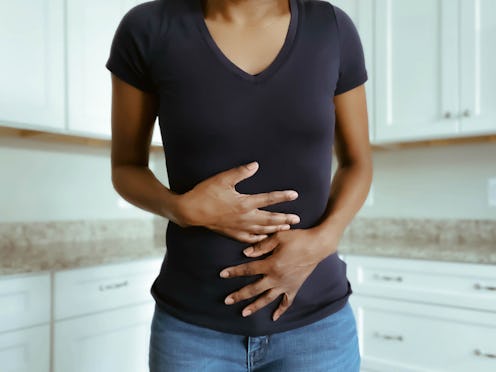Life
This Little-Known But Common Health Issue Can Affect Fertility

While some gynecological conditions, like endometriosis, are becoming more widely known, other conditions get less of the spotlight. One of them is adenomyosis, where the inner parts of the uterus, including its lining, are found in the outer walls. Though it affects around one in 10 people with uteruses, scientists are still figuring out exactly how adenomyosis affects fertility.
"Adenomyosis is a medical condition in which uterine lining cells, called endometrial glands, and their surrounding tissue, the stroma, are located within the muscle wall of the uterus, the myometrium," Dr. Felice Gersh M.D., an OB-GYN, tells Bustle. The lining of the uterus is what sheds whenever a period happens, and in people with adenomyosis, it moves away from the lining into the outer walls. Dr. Gersh says that adenomyosis tissue might form in response to trauma in the uterus walls, like surgery. Having a caesarian section, endometriosis procedure, and giving birth seem to raise the risk of adenomyosis.
"Doctors try and tell me that I have a 'chance' at getting pregnant," Danielle, 29, whose adenomyosis was discovered after extensive operations for endometriosis, tells Bustle. "The reality of it is that I cannot. However, they say pregnancy is easier when you have Adeno [than when you have endometriosis]."
How Adenomyosis Impacts Fertlity
Adenomyosis's effects on fertility are still being investigated. One theory is that in people with adenomyosis, the uterus's ability to contract properly is hampered, making it harder for sperm to move through the body to fertilize eggs.
People with adenomyosis are thought to have a greater risk of fertility issues with both IVF and natural pregnancies, but it's not quite clear why. Gabrielle Union told Women's Health in 2019 that she believed the condition was responsible for her multiple miscarriages. A study in 2019 published in F1000Research noted that 38.2% of infertile women who'd had a few pregnancy losses and 34.7% of infertile women who'd tried IVF several times had adenomyosis. The condition is also associated with early miscarriages, preterm birth, and birth complications, particularly in people over the age of 30.
Another problem may be hormones. "People with adenomyosis experience an increased local production of estrogen in the adenomyosis tissues," Dr. Gersh says. That can interfere with the uterus' daily operations and make it less hospitable for pregnancy. Inflammatory cells caused by adenomyosis can also get in the way of a fertilized egg as it tries to implant. A study published in 2017 in Minerva Ginecologica found that people with adenomyosis also have high levels of free radicals in their uteruses, which can make it an inhospitable environment for fertilized eggs.
How Do You Treat Adenomyosis To Increase Fertility?
According to a study published in Reproductive Sciences in 2018, surgery combined with hormonal treatment raised the likelihood of pregnancy. Surgery comes with risks, though. A study published in Fertility & Sterility in 2018 looked at 2,123 adenomyosis surgeries, and found that while the surgeries resulted in 449 pregnancies and 363 successful deliveries, there were also 13 cases of uterine ruptures. Some scientists are proposing high intensity focused ultrasounds as a way to heat and cauterize the adenomyosis tissue without the need for surgery, and early studies show it's pretty promising, but more work needs to be done.
Studies cited:
Buggio, L., Monti, E., Gattei, U., Dridi, D., Vercellini, P. (2018) Adenomyosis: fertility and obstetric outcome. A comprehensive literature review. Minerva Ginecologica. 70(3), 295-302. DOI: 10.23736/s0026-4784.17.04163-6.
Campo, S., Campo, V., & Benagiano, G. (2012). Infertility and adenomyosis. Obstetrics and gynecology international, 2012, 786132. https://doi.org/10.1155/2012/786132
Dueholm, M. (2018) Minimally invasive treatment of adenomyosis. Best Pract Res Clin Obstet Gynaecol. 51, 119-137. doi: 10.1016/j.bpobgyn.2018.01.016. Epub 2018 Feb 15. Review. PubMed PMID: 29555380.
Garavaglia, E., Audrey, S., Annalisa, I., Stefano, F., Iacopo, T., Laura, C., & Massimo, C. (2015). Adenomyosis and its impact on women fertility. Iranian journal of reproductive medicine, 13(6), 327–336.
Harada, T., Khine, Y. M., Kaponis, A., Nikellis, T., Decavalas, G., & Taniguchi, F. (2016). The Impact of Adenomyosis on Women's Fertility. Obstetrical & gynecological survey, 71(9), 557–568. https://doi.org/10.1097/OGX.0000000000000346
Osada, H. (2018). Uterine adenomyosis and adenomyoma: the surgical approach. Fertility and Sterility, 109(3), 406–417. doi: 10.1016/j.fertnstert.2018.01.032
Rocha, T. P., Andres, M. P., Borrelli, G. M., & Abrão, M. S. (2018). Fertility-Sparing Treatment of Adenomyosis in Patients With Infertility: A Systematic Review of Current Options. Reproductive Sciences, 25(4), 480–486. https://doi.org/10.1177/1933719118756754
Vannuccini, S., & Petraglia, F. (2019). Recent advances in understanding and managing adenomyosis. F1000Research, 8, F1000 Faculty Rev-283. https://doi.org/10.12688/f1000research.17242.1
Zhang, L., Rao, F., & Setzen, R. (2017). High intensity focused ultrasound for the treatment of adenomyosis: selection criteria, efficacy, safety and fertility. Acta Obstetricia Et Gynecologica Scandinavica, 96(6), 707–714. doi: 10.1111/aogs.13159
Expert:
Dr. Felice Gersh M.D., OB/GYN